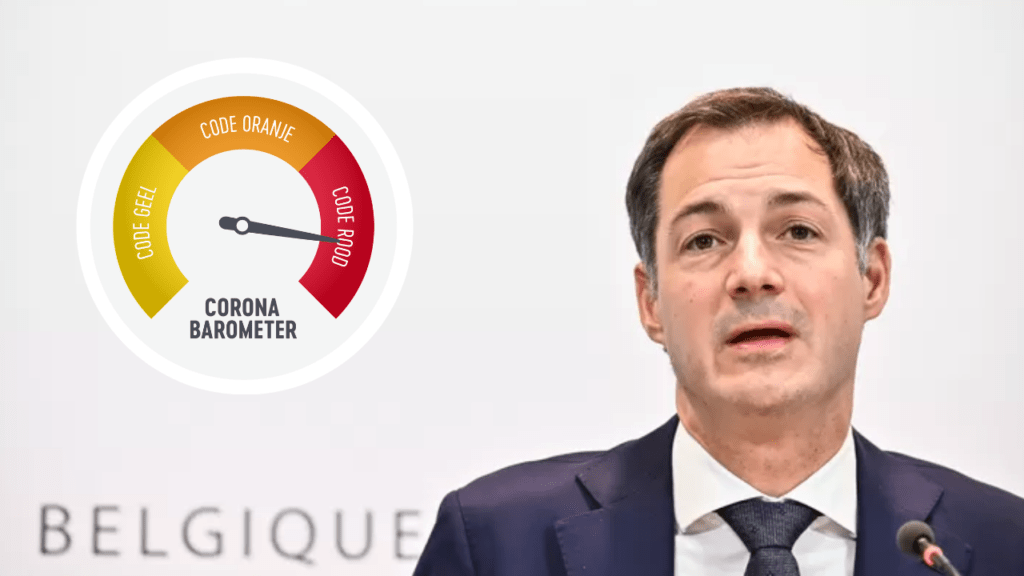Last Friday, the Consultative Committee finally implemented the long-awaited coronavirus barometer, with Belgium starting in 'code' red from Friday.
The barometer has three colour-coded phases (yellow, orange and red) that reflect the pressure on healthcare in terms of hospital admissions and intensive care patients, and set health measures accordingly.
Alongside recorded figures, upwards or downwards trends will also be assessed before any changes are made to the colour codes. Additionally, when considering Belgium's epidemiological situation as a whole, the Consultative Committee pay specific attention to mental health when deciding on changes to measures.
“The coronavirus barometer focuses on the sectors of events, organised leisure activities and the hospitality industry, but that does not mean that there will be no measures in other sectors," Corona Commissioner Pedro Facon said during a press briefing on Monday.
Belgium will start in 'code red' from Friday 28 January, but what do these colour codes really mean, and when do they take effect?
Code red
There is a "high risk of overloading the healthcare system" and stricter measures are needed to reverse the trend:
- more than 150 Covid-19 patients per day are admitted to hospital
- more than 500 beds are occupied in intensive care.
A face mask obligation is in force for staff as well as clients in the hospitality sector and at events.
The Covid Safe Ticket is required in the hospitality sector and for indoor and outdoor events. Nightclubs will be closed, and indoor events will only be possible when the public is seated.
The closing time for the hospitality sector can be set at 23:00 at the earliest or 01:00 at the latest. A maximum of six people can be seated at a table.
Additionally, the Consultative Committee can decide to limit the number of people allowed to 50-70% of a venue's maximum capacity, depending on whether the air quality requirements can be guaranteed. This applies to events as well as the hospitality sector.
Crowd management is mandatory for events, and organisers must divide the attendees into different compartments. Air quality requirements will be made stricter than in code orange. The exact norms per phase can be found here (in Dutch or French).
For group leisure activities (such as culture, youth organisations or sports), the same rules apply as in code orange but the maximum number of attendees can be limited to 50-100 indoors, and up to 200 outdoors.
Code orange
There is an "increasing pressure on the healthcare system" and intervention is needed to reverse the trend:
- more than 65 but fewer than 149 Covid-19 patients are admitted to hospital per day
- between 300 and 500 beds are occupied in intensive care.
In the hospitality sector, face masks are mandatory for staff. The public must also wear masks at non-dynamic indoor events, and outdoors only when social distancing cannot be guaranteed.
The Covid Safe Ticket is required in the hospitality sector and for both indoor and outdoor events (with the option of requiring an extra rapid antigen test at the entrance for nightclubs). For leisure activities, the CST is optional from 50 adults.
There is no closing time, but the Consultative Committee can decide to limit the number of people allowed to 60-90% of a venue's maximum capacity, depending on whether the air quality requirements can be guaranteed. This applies to events as well as the hospitality sector.
Additionally, crowd management is mandatory for events, and organisers have the option to compartmentalise the public. Air quality requirements will be made stricter than in code yellow.
For group leisure activities, intense contact should be avoided unless the nature of the activity does not allow it. The maximum number of attendees can be limited to 100-200, and all areas must be well-ventilated. In case of overnight stays, self-tests are recommended.
Code yellow
The epidemiological situation and the pressure on hospitals are under control:
- fewer than 65 Covid-19 patients are admitted to hospital per day,
- fewer than 300 beds are occupied in intensive care.
Face masks are no longer mandatory, but vulnerable people (such as the elderly or those with an underlying condition) are recommended to wear an FFP2 mask.
A Covid Safe Ticket will no longer be required to attend events or to gain entrance to hospitality establishments.
There is no closing time for the hospitality sector, no limits on the number of people allowed at events, and no crowd management needed.
To ensure sufficient ventilation, a CO2 meter must be installed and a risk analysis and action plan must be ready.
For group leisure activities, no measures are in force, but extra attention must be paid to ensure sufficient ventilation during indoor activities.
Code green and black?
Facon stressed that the barometer is "not an autopilot" and the authorities can also take stricter measures than those provided for.
"Technically, we could also have a 'code black', where the situation is very bad and the Consultative Committee has to decide whatever measures necessary," he said, referring to very strict measures like sector closures or even a lockdown.
"However, the opposite is also true: we expect there to come a time when the barometer is no longer necessary," Facon said. "'Code green' would be when the barometer is not in force and no measures are needed at all. We are not there yet, but I do think we are entering a new phase," he said. However, no clear thresholds have been set to determine when the barometer can be discontinued.
"Immunity has risen immensely because of the vaccines, the boosters and the fact that so many people have already been infected," Facon added. "But we must be cautious: we have had too many 'reality checks' in recent years."

